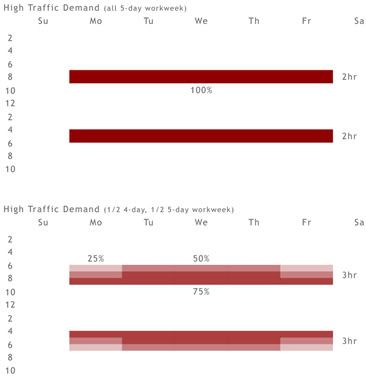
A couple weeks ago, in an article 4-Day Work Week Is The Future, Shaun Lumachi covered an interesting piece of state legislation, introduced by Assemblyperson John Benoit (R-Riverside). Known as the Small Business Family Scheduling Option, this legislation proposes to condense the regular work week from five 8-hour days to four 10-hour days. The purpose of this bill is to provide employees and employers in small businesses the ability to negotiate more flexible work schedules. This is a wonderful initiative that, as Shaun rightly points out, could lead to a greater quality of life for the working families of California.
The concept of the five-day, 40-hour work week has become a national standard since it was created over eighty years ago by Henry Ford in his factories. During this major industrial period in American history, such a regular work schedule created a safer work environment, as employees were better able to concentrate on their tasks due to uniform rest periods. Though seen by many to be a victory for workers’ rights, Ford’s reasoning was less altruistic; one key purpose was to turn his workers into consumers by giving them more leisure time.
While there might certainly be a “feel-good” dimension to this proposed legislation, let us focus on its pragmatic implications with regard to California’s workforce. Crucially, this legislation could play a key role in alleviating the impacts of the state’s growing population on our strained transportation system. Shaun touched on this issue when discussing how a schedule where some persons commuted to and from their workplaces only four days a week, rather than five, would reduce air pollution.
For the most part, local and regional transportation networks are designed with the twenty hours a week or so of peak use in mind. This represents just over ten percent of any week. As a result, outside of the hours of 7:00–9:00 a.m. and 4:00–6:00 p.m., the state’s roadways are typically nowhere near their full capacity. In many cases nationwide, transportation agencies try to reduce commute times by expanding roadways and improving intersections. However, this approach is extremely costly and for many cities like Long Beach is no longer feasible due to their “built-out” nature.
The Small Business Family Scheduling Option legislation has the potential to significantly reduce rush-hour traffic in several ways, all at a considerably lower cost than methods like expanding roadways. The most obvious and direct potential benefit is that a four-day work week involves 20% less commuting than a five-day work week. In addition, staggering the resulting three-day weekend, so that some workers have Friday-Sunday off and others have Saturday-Monday off, spreads the benefit of reduced traffic to two of the five regular work days (leaving only Tuesday, Wednesday, and Thursday as days where everyone is commuting); in other words, 40% of the work week could see reduced traffic.
In addition, introducing 10-hour work days for portions of the workforce would mean that for these workers, commuting would begin an hour earlier and end an hour later than for workers on an 8-hour work day. The result is that this proposed legislation could spread out the “rush hour” period, thereby further easing traffic congestion.
All of these possible mitigations of congestion would depend on the number of persons switching to a four-day, 10-hour work schedule. The figure below shows how the proposed legislation might work if half the designated workforce were to participate, with half of the four-day work weeks starting on Mondays and the other half on Tuesdays.

It is not necessarily the case that the reduction in traffic congestion would stem from eliminated car trips; the benefit might originate instead from simply shifting the time of such trips. This is because the work-related commuting eliminated as the result of a four-day work week might just be replaced by more car trips for leisure and errands during the extended weekend. For this reason the argument that this legislation would decrease air pollution is questionable, although in the short term some reductions might occur due to shorter commute times (and also the possibility that trips for leisure and errands might be shorter than trips to work). A true transportation management strategy, one that included alternatives for transit and ride sharing, would in all likelihood be necessary to see substantial net gains in environmental quality.
Beyond the obvious benefits due to more flexible work schedules, the real advantage of the Small Business Family Scheduling Option legislation could be in avoiding the need for costly transportation infrastructure improvements due to traffic congestion. The potential cost savings in this regard are significant, perhaps to the extent that the state could offer financial incentives for businesses to offset any costs associated with providing flexible work weeks. In reality, more and more businesses are finding flexible work weeks to be an effective recruitment and retention tool in a competitive market.
Henry Ford’s days of the rigid assembly line are largely past: we face now a complex information economy that places varied demands on worker time and productivity. Thus, this legislation stands to benefit our region from every perspective—economic, environmental, and social.
